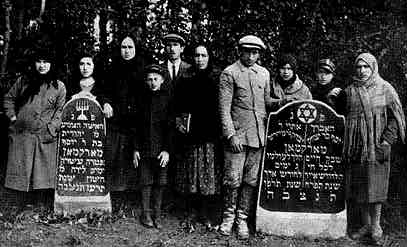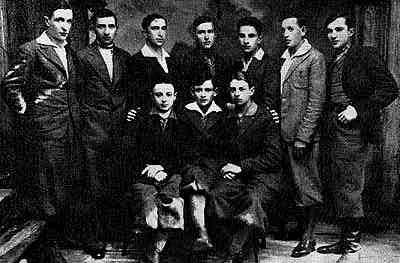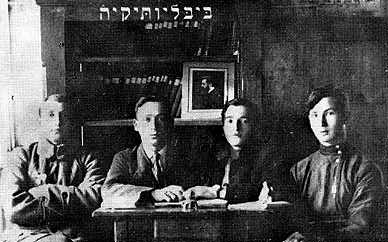
|
|
(Memories, Manners, Images)
[Page 51]
Dokshitz, my shtetl--you stand now before my eyes. From the earliest childhood years, with the kheyders where mischievous youngsters learned, with the school where teachers implanted Jewish and general studies in us.
I am reminded of a parade on Lag Ba'Omer, with the national flags and slogans, "Long Live our National Language!" Then comes a Keren Kayemet Bazaar with the lovely exhibits and drawings, which emboldened the youth to transform during a folk-demonstration from love and sincerity to a Zionist mindset. And the lively ebullient youth-organizations: HaShomer HaTzair, HeChalutz, HeChalutz HaTzair, Beitar, Com-yung. Everywhere a flurry of activity, discussions full of zeal and passion. Evening group meetings with heated arguments that sometimes ended in blows. And overall--there
[Page 52]
was joy! A comrade travels to the Land of Israel. The entire shtetl sends him off with song and dance, on the bridge they dance a "hora," and then the traveler commences on his long journey.
The noise of the matza hearth ovens announces the approaching Passover. Milkhiks [dairy foods], Tisha B'Av--with shtekhekhtz [little thorns thrown in beard in an Eastern European custom for the holiday Tisha B'Av]. Dressed up and festive girls, strolling to the synagogue on Rosh Hashana to hear the shofar blow. By the river a multitude of Jews stands shaking out their pockets, they free themselves of all of their sins from the previous year. Later, the pre-Yom Kippur atonement ceremony of shlogn kapores begins. On the eve of Yom Kippur, Jews wrapped in talisim [prayer shawls] and kittles [white robes] fast and pray more than a day and a night in the full synagogues, where the lights burn non-stop. Kol Nidrey-it is a tremendous experience for all the Jews in the shtetl.
Here runs the shames [sexton] with an esrog [citron] and lulov [palm fronds] to the women, so they don't miss this mitzvah [commandment]. And the streets become filled with joy as do all six basey midrashim [houses of study and prayer]-Simchas Toyrah is upon you, Jews. In a state of light drunkenness the congregation begins hokofes [circuitous procession around the synagogue the Torah scroll]. Blessings with "Shehaklen" [benedictions over drink] over full cups, entire families wishing a "l'chayim" [toast to life]!
Again, the gray weekdays return, with the old worries and troubles. Quietly a funeral procession goes to the cemetery and the pine-trees rock themselves to the cadence, and shade the

[Page 53]
1939. The Red Army marches into Dokshitz on those famous September days. All social worries fall on the state. But of the one-time Jewish institutions not a memory remains. Only the dramatic circle expands its activity and the chorus sings new songs about victory and happiness. But this does not continue for long. . The accursed swastika with its four venomous snakeheads spread out its reign over Europe and also reached Dokshitz. A dark cloud set itself upon the Jewish heads in the shtetl. Yet even in those difficult days of the ghetto our brothers, the children of Israel did not lose the image of God. The strong assist the weak in deeds and help. And when the last hope was put out, they showed their valor, approaching death with calm, dignity and resistance. Is there any greater heroism than that of the Jewish mother in Dokshitz, who injected her own child with morphine, to ease his passage into death? Or the young man already shot through, with the bullet in his back, who jumped out of the mass grave and attacked the murderer? Or the captive young man, the soldier who took him to be shot, suddenly grabbed the gun out of his hand and ran with it into the forest to the partisans? Or the heroism of the Dokshitz mother who took her three daughters and with heads held high walked towards her murderers?
Now all has ended. There are no more Jews in the shtetl. Jus a cemetery that once was, with the holy grave from whence come the last moan and silenced cry of old people, women, children: "Do not ever forget what happened to us! Always carry our memory inside yourself!"
[Page 54]

Several of the Youth of Dokshitz before their Induction (Draft) into the Polish Army
The four most important streets, which intersected in the market from four different directions were called: Polotzker, Borissover, Dolhinover, Gluboker. Many little streets branched out from these streets and most of them made their way to the synagogue courtyard-there was also another quadrangular place between the beys-hamidrash and the shtibelekh [little synagogues]: Starosheler, Libavitzer, Liyader and Slaboder. Opposite all of these houses of prayer were the workshops of the Dokshitz Jewish tailors, cobblers, gaiter/boot-makers, tinsmiths. The small muddy streets were inhabited by the wagon drivers and butchers. Here were the kheyders [small religious schools], where teachers ruled ;by whips, or the more liberal who punished a student with copying or learning chapters of the Psalms by heart, or blessing the new moon, or the "Y'hi Ratzon" prayer of the Rosh Khodesh [new month] service. Of course, the greater the "transgression"-the greater the "punishment." It was, however, a fact, that the students of the encouraging teachers learned much better than those who were whipped.
[Page 55]
The part of the shtetl, inhabited by Amkho [your people], simple Jews, also made its living from the beer brewery, two mills, a sawmill and the special bakeries and ovens for baking matzah for every Passover eve. The machine for rolling matzah was new and was operated by a hand crank. Since there was no industry in the shtetl, there was not sufficient work for the five thousand residents nor sufficient livelihood. The so called lower class elements, the workless and moneyless, sought a bit of earnings in petty trade at the market, or in surrounding villages, not numbering many, because not far from us-some 7-8 kilometers, was the Soviet border. People only let themselves go in the direction of Gluboki and Dolhinov in search of work, the most important of them going to haggle first and sell the ripe fruit to the wholesalers or store it for winter. There was exchange with the village, buying and selling of wheat, flax, eggs, chickens and geese, which were bought in autumn, kept and tended in the garret, stable, cell or even in the anteroom until Chanukah in order to derive shmaltz [fat] for Passover and to use it for the delicious latkes [potato pancakes]. Feathers from the slaughtered geese were plucked for featherbeds, cushions and pillows. The work was done for grozshn ["pennies," lit. smallest amount of Polish money/coin], in the long winter nights.
The full picture of business for Jews in Dokshitz is not yet complete. We also had matchmakers, brokers, sextons, cantors, ba'aley tfiles [leaders of prayer services], psalm sayers [for the dead-it is the tradition that psalms must be read aloud for the dead from the time of death until the time of burial], shroud embroiderers, those who practiced cupping [for the purpose of blood letting as a remedy for ailments], ritual attendants at the bathhouse and mikveh [ritual bath], cooks for weddings and suppers, waiters, guardians, porters-and not just a few charity collectors. And over all of them-the arrogance of certain wealthy people, even very affluent, in the shtetl: wood merchants, merchants of flax and seeds, millers, partners in pitch burning, cooperatives, hotel owners, restaurateurs, some land owners, those employed by lords,
Regarding the support from overseas, it was known that almost a half of the Jews in the shtetl benefited from it. Nevertheless most people were over their heads with worries about income and the general economic position of the population was not very high. Therefore, the Jews created many institutions and organizations, which had as their mission to mitigate the necessities of the needy and also to morally, encourage and support them.

The Bundist and Yiddishist elements founded a Jewish folk-school with great effort where the teachers, working there for a "hunger-wage" [i.e., very little], displayed a lot of idealism and devotion. Both directions-The Zionist-Hebraist and the Bundist-Yiddishist, also influenced the students in the Polish school who were not estranged form the Jewish area and gave their contribution to the lively societal activities.
In order to insure the existence of the schools, which consistently found themselves in a difficult material position, dramatic circles were created, which in addition to giving, the satisfaction of good performances, also enriched the tills of the schools.
The library was an important stimulus for the cultural development of the city.
"Keep the book clean, do not tear it-because it is a communal possession!" Every book in the Dokshitz library had this stamped on its cover. The youth, after finishing one of the folk schools, still yearned for knowledge and wanted to study further, the folk library was their only "high school." Only a very few boys from privileged homes had the opportunity to continue in gymnasium [high school] in Vilna, three or four even traveled to France to study, while most young people used the library which possessed a rich collection of the better books of Jewish and general literature. The popular editions from the "Grozshn Library" [Penny Library] also gave the youth the impulse to contemplate, discuss and debate the works of the classics and the poli-societal problems.
[Page 58]
The influence of the library upon the growing youth did not take long. The different party ideologies and movements which came from outside, with the help of the folk-library and its books, allowed for the fact that in Dokshitz all of the organizations that were active in Poland were represented. Our youth participated in HaShomer HaTza'ir, HeChalutz, Po'alei Tzion, HeChalutz HaTza'ir, Communists, later-Revisionists and Beitar.
The club evenings, lectures and discussions in the street and at home showed the political growth and Jewish involvement of the youth. There were membership drives for Zionist causes, separate from the Keren Kayemet, Keren Aliya and bazaars. Literary evenings and presentations have already been mentioned.
The first pioneers leave for Hachshara [training and immigration to Israel in a rural development movement]. At different times uniformed youth of HaShomer HaTza'ir, Beitar and HeChalutz would often march across the Dokshitz streets. The illegal communist youth pushes its conspiratory platform. The conflicts and meetings of the Zionist and anti-Zionist youth become more frequent. When one group has gathered for Keren Kayemet, the second delivers a contribution for Mopar (aid for the political prisoners). Illegal literature surfaces in the shtetl and from time to time a red flag is hung on the telephone poles. People also begin stealing across the border in to Russia, which was also full of much danger. But there were also some who were privileged to make Aliyah to Israel, or seldomly go to Hachsharah training.
Clearly, the Jewish struggle was also a result of the difficult economic situation in which the Jewish population found itself, especially the youth. The unemployment was high; there was not always enough food to satisfy.
|
|
JewishGen, Inc. makes no representations regarding the accuracy of
the translation. The reader may wish to refer to the original material
for verification.
JewishGen is not responsible for inaccuracies or omissions in the original work and cannot rewrite or edit the text to correct inaccuracies and/or omissions.
Our mission is to produce a translation of the original work and we cannot verify the accuracy of statements or alter facts cited.
 Dokshitz, Belarus
Dokshitz, Belarus
 Yizkor Book Project
Yizkor Book Project
 JewishGen Home Page
JewishGen Home Page
Copyright © 1999-2026 by JewishGen, Inc.
Updated 19 Feb 2003 by LA